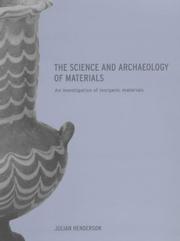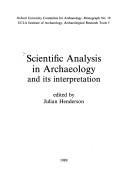| Listing 1 - 10 of 11 | << page >> |
Sort by
|

ISBN: 0415199344 9780415199346 Year: 2000 Publisher: London ; New York Routledge
Abstract | Keywords | Export | Availability | Bookmark
 Loading...
Loading...Choose an application
- Reference Manager
- EndNote
- RefWorks (Direct export to RefWorks)
Anorganische verbindingen --- Composés inorganiques --- Compounds [Inorganic ] --- Inorganic chemicals --- Inorganic compounds --- Verbindingen [Anorganische ] --- Archaeological chemistry --- Archaeology --- Glass manufacture --- Pottery --- Metal-work --- Stone implements --- Chimie archéologique --- Archéologie --- Verre --- Céramique --- Métaux, Travail des --- Outils de pierre --- Methodology --- Analysis --- Méthodologie --- Fabrication --- Analyse --- Ceramics --- Chimie archéologique --- Archéologie --- Céramique --- Métaux, Travail des --- Méthodologie --- Analysis. --- Methodology. --- Archaeological chemistry - Methodology --- Archaeology - Methodology --- Ceramics - Analysis --- Metal-work - Analysis --- Stone implements - Analysis
Multi
ISBN: 9781107551909 9781107006737 9781139021883 Year: 2013 Publisher: Cambridge Cambridge University Press
Abstract | Keywords | Export | Availability | Bookmark
 Loading...
Loading...Choose an application
- Reference Manager
- EndNote
- RefWorks (Direct export to RefWorks)
"This book provides an integrated interdisciplinary approach to the study of a complex and fascinating ancient material. A variety of aspects of ancient glass is discussed including principally archaeology, history, chemical analysis, materials science, geology and botany. The aims of the book are to explore these aspects by using a combination of focused studies and case studies in a variety of ancient and historical periods. Each case study, in Bronze Age Mesopotamia, Late Hellenistic-early Roman Middle East and the Islamic world, has been selected so as to incorporate contrasting social, political, economic and ritual contexts in which glass was manufactured, traded and used. These contrasting characteristics of societies therefore influenced the ways in which glass fitted into society: the ways in which it was manufactured and used. The relationships between production, trade and use of ancient materials including glass are complex. The scale of production involving a range of facilities and critical combinations of raw materials from a variety of sources were characteristic of the specific society and their ideologies. Each step in the chan̋e oppřatoire involved decisions, each with a social impact and significance leading to the manufacture of glass artefacts characteristic of that society. The control over each aspect of production was a reflection of the degree of social hierarchy, (perhaps involving social elites) and complexity at the time"--
History of civilization --- Applied arts. Arts and crafts --- Glass --- Glass manufacture --- History --- Glassware, Ancient. --- Glassware, Classical. --- Social science --- History. --- Archaeology. --- Verrerie antique --- Verre --- Fabrication --- Histoire
Book
ISBN: 1107234344 1139610074 1139611933 1139621238 1283943069 1139624954 1139608525 1139615653 1139021885 1107006732 1107551900 Year: 2013 Publisher: Cambridge : Cambridge University Press,
Abstract | Keywords | Export | Availability | Bookmark
 Loading...
Loading...Choose an application
- Reference Manager
- EndNote
- RefWorks (Direct export to RefWorks)
This book is an interdisciplinary exploration of archaeological glass in which technological, historical, geological, chemical and cultural aspects of the study of ancient glass are combined. The book examines why and how this unique material was invented some 4,500 years ago and considers the ritual, social, economic and political contexts of its development. It also provides an in-depth consideration of glass as a material, the raw materials used to make it, and its wide range of chemical compositions in both the East and the West from its invention to the seventeenth century AD. Julian Henderson focuses on three contrasting archaeological and scientific case studies: Late Bronze Age glass, late Hellenistic-early Roman glass, and Islamic glass in the Middle East. He considers in detail the provenances of ancient glass using scientific techniques and discusses a range of vessels and their uses in ancient societies.
Glassware, Ancient. --- Glassware, Classical. --- Glass manufacture --- Classical glassware --- Ancient glassware --- History. --- Social Sciences --- Archeology
Book
Year: 1970 Publisher: Rome : Organisation des Nations Unies pour l'alimentation et l'agriculture,
Abstract | Keywords | Export | Availability | Bookmark
 Loading...
Loading...Choose an application
- Reference Manager
- EndNote
- RefWorks (Direct export to RefWorks)
Book
Abstract | Keywords | Export | Availability | Bookmark
 Loading...
Loading...Choose an application
- Reference Manager
- EndNote
- RefWorks (Direct export to RefWorks)
Book
Abstract | Keywords | Export | Availability | Bookmark
 Loading...
Loading...Choose an application
- Reference Manager
- EndNote
- RefWorks (Direct export to RefWorks)
Book
ISBN: 9789058676900 9789461660510 9461660510 9058676900 Year: 2009 Volume: 1 Publisher: Leuven Leuven University Press
Abstract | Keywords | Export | Availability | Bookmark
 Loading...
Loading...Choose an application
- Reference Manager
- EndNote
- RefWorks (Direct export to RefWorks)
For all archaeological artefactual evidence, the study of the provenance, production technology and trade of raw materials must be based on archaeometry. Whereas the study of the provenance and trade of stone and ceramics is already well advanced, this is not necessarily the case for ancient glass. The nature of the raw materials used and the geographical location of their transformation into artefacts often remain unclear. Currently, these questions are addressed by the use of radiogenic isotope analysis. With the specific information the technique provides, archaeologists can further their understanding of the of ancient glass production, based not only on typo-morphological features but also on exact scientific methods. The book captures the state of the art in this rapidly advancing field. It includes methodological papers on isotope analysis, innovative applications of several isotope systems to current questions in glass and glaze research, and advances in the knowledge of the economy of vitreous materials.
Academic collection --- 902 --- Archeologie --- 902 Archeologie --- glass [material] --- Nuclear chemistry --- archaeometry --- fysicochemie --- Industrial archeology --- Glass --- Archaeometry --- Archaeology --- Art --- Methodology --- Analysis --- History --- Methodology. --- Analysis.

ISBN: 0917956664 9780917956669 0947816194 Year: 1989 Publisher: Oxford : Oxford university. Institute of archaeology,
Abstract | Keywords | Export | Availability | Bookmark
 Loading...
Loading...Choose an application
- Reference Manager
- EndNote
- RefWorks (Direct export to RefWorks)
Archaeology --- Antiquities --- Archaeological specimens --- Artefacts (Antiquities) --- Artifacts (Antiquities) --- Specimens, Archaeological --- Material culture --- Methodology. --- Analysis. --- Use of --- Science --- Methodology --- Analysis
Book
ISBN: 9749116593 Year: 2003 Publisher: London The Bead Study Trust
Abstract | Keywords | Export | Availability | Bookmark
 Loading...
Loading...Choose an application
- Reference Manager
- EndNote
- RefWorks (Direct export to RefWorks)
Book
ISBN: 0954444507 Year: 2003 Publisher: London : Islamic Art Society,
Abstract | Keywords | Export | Availability | Bookmark
 Loading...
Loading...Choose an application
- Reference Manager
- EndNote
- RefWorks (Direct export to RefWorks)
| Listing 1 - 10 of 11 | << page >> |
Sort by
|

 Search
Search Feedback
Feedback About UniCat
About UniCat  Help
Help News
News